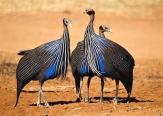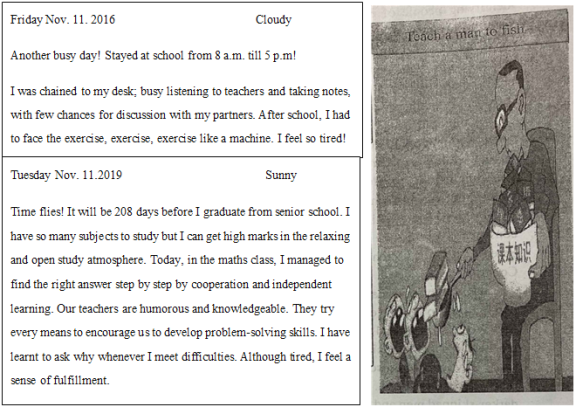题目内容
【题目】 A group of blue-faced birds step through the grass shoulder to shoulder, red eyes looking around. They look like middle schoolers seeking a cafeteria table at lunchtime. Perhaps they’re not so different.

A new study, led by Damien Farine, an ornithologist who studies collective behaviour, shows that the vulturine guineafowl of eastern Africa, like humans, have multilevel societies. In the past, scientists assumed such social structures required a lot of brainpower. But the pea-brained guineafowl are revealing the faults in that assumption.
These large birds wander across the landscape in packs, often walking so closely that their bodies touch. They may fight each other to maintain their strict hierarchies (等级制度), but at other times they engage in friendly behaviours like sharing food.
Suspecting the guineafowl might have a social structure, Dr. Farine and his colleagues began a thorough study of their society. For a whole year, they made daily observations of 441 birds. Coloured leg bands in unique combinations let researchers tell the black-and-blue birds apart. They also attached GPS devices to the backs of 58 birds, which let them see exactly where every group went, 24 hours a day.
The findings of the research suggest that the vulturine guineafowl have a multilevel society. There are groups within groups within the population as a whole. There even seem to be groups of friends within the small groups. This is the first time anyone has observed such a society in a bird.
And Dr. Farine emphasizes this particular bird’s tiny brain size: “They don’t only have small brains relative to mammals (哺乳动物), they also have quite small brains relative to other birds,” he said.
According to him, living in this kind of society might actually make it easier to keep track of the social order. For example, if groups are stable and a bird can identify just one or two individuals within a group, it knows which group it’s looking at — no need for a brain that can recognize every single animal. Multilevel societies also let animals adjust their group sizes based on whatever challenges they’re facing. Depending on what enemies or resources are around, it might make sense to travel in a combined group rather than a smaller one.
“Having a multilevel structure may not require having a large brain,” Dr. Farine said. There may be more birds and other animals out there that, although small-brained, have societies as many-leveled as our own.
【1】According to the passage, what inspired Dr. Farine to carry out the study?
A.The guineafowl’s social behaviour.
B.Previous assumptions about birds.
C.His interest in animal brainpower.
D.The faults in earlier research.
【2】What is Paragraph 4 mainly about?
A.The research subjects.B.The research methods.
C.The research findings.D.The research equipment.
【3】What can be learned from the passage?
A.Complex social systems can be a disadvantage to the guineafowl.
B.The guineafowl are good at recognizing individuals in a group.
C.Birds maintain social order by travelling in combined groups.
D.Small-brained animals can form multilevel societies.
【4】What is the main purpose of the passage?
A.To present the findings of a study of the guineafowl.
B.To explain the interaction patterns in multilevel societies.
C.To introduce a new approach to observing the guineafowl.
D.To uncover clues about how complex societies are formed.
【答案】
【1】A
【2】B
【3】D
【4】A
【解析】
这是一篇说明文。文章主要讲了鸟类学家Damien Farine团队在非洲东部的一项新的研究发现:小脑动物珍珠鸡也有社会结构。
【1】推理判断题。由第四段中的Suspecting the guineafowl might have a social structure, Dr. Farine and his colleagues began a thorough study of their society.可知,由于怀疑珍珠鸡可能有社会结构,Farine博士和他的同事们开始对它们的社会进行彻底的研究。由此可知,珍珠鸡的社会行为和社会结构让Farine博士和他的同事们有所怀疑,所以他们才进行了彻底的研究。故选A项。
【2】主旨大意题。由第四段中的For a whole year, they made daily observations of 441 birds. Coloured leg bands in unique combinations let researchers tell the black-and-blue birds apart. They also attached GPS devices to the backs of 58 birds, which let them see exactly where every group went, 24 hours a day.可知,一整年,他们每天观察441只鸟。独特组合的彩色腿带让研究人员区分了黑蓝色的鸟类。他们还在58只鸟的背上安装了GPS设备,让它们一天24小时准确地看到每一组鸟的去向。由此可知,这段主要是讲述他们团队如何研究观察的,即他们的研究方法。故选B项。
【3】推理判断题。由第五段中的The findings of the research suggest that the vulturine guineafowl have a multilevel society.和第六段中的And Dr. Farine emphasizes this particular bird’s tiny brain size: “They don’t only have small brains relative to mammals (哺乳动物), they also have quite small brains relative to other birds,” he said.可知,研究结果表明,秃鹰珍珠鸡具有多层次的社会结构。Farine博士还强调了这种鸟的大脑很小:“它们不仅与哺乳动物相比,大脑很小,而且与其他鸟类相比,它们的大脑也很小。”由此推知,大脑很小的珍珠鸡也有社会结构。故选D项。
【4】推理判断题。结合文章大意,这篇文章主要介绍了Farine博士团队的研究发现:大脑很小的珍珠鸡也有社会结构。所以文章的目的是向我们展示对于珍珠鸡的研究发现。故选A项。

 名校课堂系列答案
名校课堂系列答案